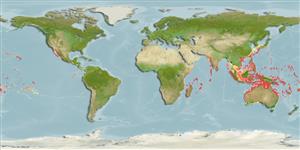>
Kurtiformes (Nurseryfishes, cardinalfishes.) >
Apogonidae (Cardinalfishes) > Apogoninae
Etymology: Apogon: Greek, a = without + Greek pogon = chin, beard (Ref. 45335).
More on author: Garman.
Environment: milieu / climate zone / depth range / distribution range
Οικολογία
Θαλασσινό(ά) Υφαλόφιλο(α); εύρος βάθους 18 - 55 m (Ref. 37816). Tropical
Indo-Pacific. Replaced by Apogon coccineus from the Red Sea to Persian Gulf and by Apogon erythrinus in the Hawaiian Islands (Ref. 37816).
Μέγεθος / Βάρος / Age
Maturity: Lm ? range ? - ? cm
Max length : 5.0 cm TL αρσενικό/απροσδιόριστο; (Ref. 90102); common length : 4.5 cm SL αρσενικό/απροσδιόριστο; (Ref. 37816)
Ραχιαίες άκανθες (συνολικά): 7; Μαλακές ραχιαίες ακτίνες (συνολικά): 9; Εδρικές άκανθες 2; Μαλακές εδρικές ακτίνες: 8. Distinguished by having the following characteristics: dorsal-fin rays VI-I, 9; anal-fin rays II,8; pectoral fin rays 13; pelvic fin rays I,5; pored lateral line scales 24; predorsal scales 5-6; large scale between first dorsal fin and lateral line 1; circumpeduncular scales 12; total gill rakers 15-16, developed gill rakers 8-9; full scale between first dorsal fin and lateral line 1, often with smaller second scale (Ref. 93839). Resembles A. unicolor but distinguished by fewer spines in the 1st dorsal fin (6 against 7), large scales, and fewer lateral line scales (23 against 25). Body color uniformly dark reddish, each scale mottled with brown. Attains 10 cm TL. Further characterized by having a semi-transparent red color, with a thin, dark red stripe on mid-lateral surface of the body (Ref. 93839) greatest depth of body 2.7-3.0 in SL (Ref. 90102).
Found on inshore reefs, lagoons, and seaward reefs (Ref. 37816). Nocturnal species (Ref. 7300). Feeds on small benthic crustaceans (Ref. 37816). Maximum depth reported taken from Ref. 57178.
Life cycle and mating behavior
Γεννητική Ωρίμανση | Αναπαραγωγή | Γεννοβολία | Αβγά | Γονιμότητα | Προνύμφες
Mouthbrooders (Ref. 240). Distinct pairing during courtship and spawning (Ref. 205).
Paxton, J.R., D.F. Hoese, G.R. Allen and J.E. Hanley, 1989. Pisces. Petromyzontidae to Carangidae. Zoological Catalogue of Australia, Vol. 7. Australian Government Publishing Service, Canberra, 665 p. (Ref. 7300)
IUCN Red List Status (Ref. 130435)
Threat to humans
Harmless
Human uses
Περισσότερες πληροφορίες
ΑναφορέςΥδατοκαλλιέργειεςΠροφίλ υδατοκαλλιέργειαςΣτελέχοιΓενετικήElectrophoresesΚληρονομικότηταΑσθένειεςΜεταποίησηNutrientsMass conversion
ΣυνεργάτεςΦωτογραφίεςStamps, Coins Misc.ΉχοιΣιγκουατέραΤαχύτηταΚολυμβητικός ΤύποςΕπιφάνεια βραγχίωνOtolithsΕγκέφαλοιΌραση
Εργαλεία
Special reports
Download XML
Διαδικτυακές πηγές
Estimates based on models
Preferred temperature (Ref.
123201): 23 - 28.5, mean 27 °C (based on 152 cells).
Phylogenetic diversity index (Ref.
82804): PD
50 = 0.5000 [Uniqueness, from 0.5 = low to 2.0 = high].
Bayesian length-weight: a=0.01479 (0.00690 - 0.03171), b=3.09 (2.91 - 3.27), in cm total length, based on LWR estimates for this (Sub)family-body shape (Ref.
93245).
Τροφικό Επίπεδο (Ref.
69278): 3.5 ±0.50 se; based on food items.
Ελαστικότητα (Ref.
120179): Υψηλό, ελάχιστος χρόνος για διπλασιασμό πληθυσμού < 15 μήνες (Preliminary K or Fecundity.).
Fishing Vulnerability (Ref.
59153): Low vulnerability (10 of 100).
Nutrients (Ref.
124155): Calcium = 281 [116, 644] mg/100g; Iron = 1.64 [0.79, 3.41] mg/100g; Protein = 18.4 [16.9, 19.9] %; Omega3 = 0.142 [0.053, 0.381] g/100g; Selenium = 52 [17, 138] μg/100g; VitaminA = 39.4 [8.1, 194.1] μg/100g; Zinc = 2.8 [1.6, 4.7] mg/100g (wet weight);
